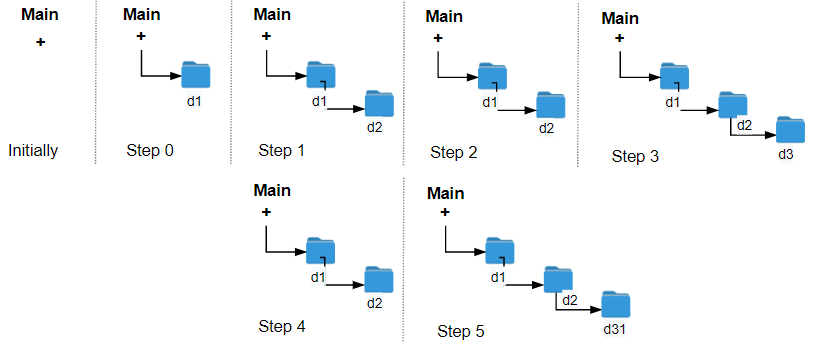- Notifications
You must be signed in to change notification settings - Fork 266
Crawler Log Folder
- 🔗 Leetcode Link: Crawler Log Folder
- 💡 Problem Difficulty: Easy
- ⏰ Time to complete: 15 mins
- 🛠️ Topics: Recursion
- 🗒️ Similar Questions: Valid Palindrome, Shortest Distance to a Character, Check Distances Between Same Letters
Understand what the interviewer is asking for by using test cases and questions about the problem.
- Established a set (2-3) of test cases to verify their own solution later.
- Established a set (1-2) of edge cases to verify their solution handles complexities.
- Have fully understood the problem and have no clarifying questions.
- Have you verified any Time/Space Constraints for this problem?
Be sure that you clarify the input and output parameters of the problem:
- How should I handle an empty log file?
- All log files will have at least one input
- What are the time and space constraints?
- Time should be
O(N)and space should beO(1)including the recursive stack,Nbeing the length of the logs
- Time should be
Run through a set of example cases:
HAPPY CASE Input: logs = ["d1/","d2/","../","d21/","./"] Output: 2 Explanation: Use this change folder operation "../" 2 times and go back to the main folder.
Input: logs = ["d1/","d2/","./","d3/","../","d31/"] Output: 3
EDGE CASE Input: logs = ["../"] Output: 0Match what this problem looks like to known categories of problems, e.g. Linked List or Dynamic Programming, and strategies or patterns in those categories.
- Sort
- Not helpful, we need to maintain the relative order of the logs
- Two pointer solutions (left and right pointer variables)
- Not helpful, we need to move in one direction
- Storing the elements of the array in a HashMap or a Set
- Not helpful, how does the hashmap help us find the distance between characters
- Traversing the array with a sliding window
- Not helpful, we are not looking for a window size
- Stack
- When dealing with file system traversal, stack is a good choice
Plan the solution with appropriate visualizations and pseudocode.
General Idea: We will recursively find the depth of the file traversal logs and that will be the minimum operations to return to root.
1. Write a recursive function to drill into the file system. a. Set the basecase: Out of bound. b. Update depth base on log function string c. Call recursive function on next log item 2. Call the recursive function 3. Return the result.General Idea: We will iteratively find the depth of the file traversal logs and that will be the minimum operations to return to root.
1. Create a stack 2. Add/Remove items from stack 3. Return the size of stack.- Using iterative approach will work here, however the interviewer wants the recursive solution.
Implement the code to solve the algorithm.
Recursive
class Solution: def minOperations(self, logs: List[str]) -> int: depth = 0 # Write a recursive function to drill into the file system def helper(i): # Set the basecase: Out of bound if i > len(logs) - 1: return # Update depth base on log function string nonlocal depth if logs[i] == "../": if depth > 0: depth -= 1 elif logs[i] == "./": pass else: depth += 1 # Call recursive function on next log item helper(i + 1) # Call the recursive function helper(0) # Return the result return depthclass Solution { int depth = 0; public int minOperations(String[] logs) { // Call the recursive function helper(logs, 0); // Return the result return depth; } // Write a recursive function to drill into the file system private void helper(String[] logs, int i) { // Set the basecase: Out of bound if (i > logs.length - 1) return; // Update depth base on log function string if (logs[i].equals("../")) { if (depth > 0) { depth--; } } else if (logs[i].equals("./")) { ; } else { depth++; } // Call recursive function on next log item helper(logs, i+1); } }Iterative
class Solution: def minOperations(self, logs: List[str]) -> int: # Create a stack stack = [] # Add/Remove items from stack for log in logs: if log == "../": if stack: stack.pop() elif log == "./": continue else: stack.append(log) # Return the size of stack return len(stack)class Solution { public int minOperations(String[] logs) { // Create a stack var stack = new Stack<String>(); //Add/Remove items from stack for(var log : logs){ if(log.equals("../")){ if(!stack.empty()) stack.pop(); }else if(log.equals("./")){ }else{ stack.push(log); } } // Return the size of stack. return stack.size(); } }Review the code by running specific example(s) and recording values (watchlist) of your code's variables along the way.
- Trace through your code with an input to check for the expected output
- Catch possible edge cases and off-by-one errors
Evaluate the performance of your algorithm and state any strong/weak or future potential work.
Assume N represents the size of array
- Time Complexity: O(N) because we will run the algorithm once to process all logged commands
- Space Complexity: O(1) because the recusive call does not need to be stored in memory. Technically this called Tail recursion, a recursion of a function where it does not consumes stack space and hence prevents stack overflow.